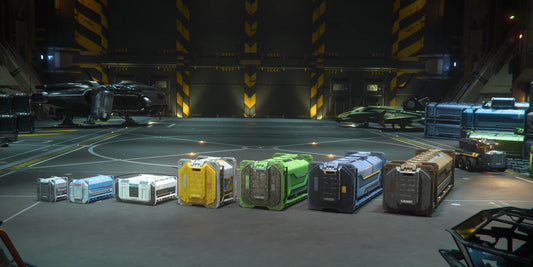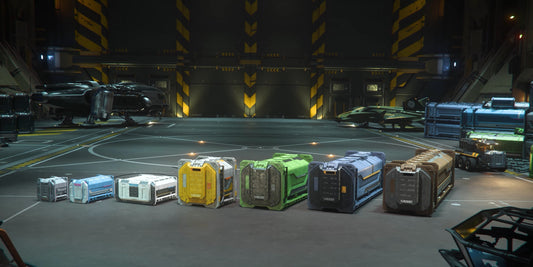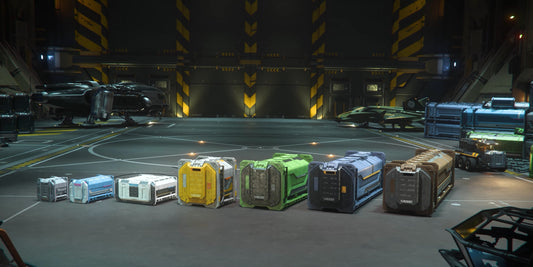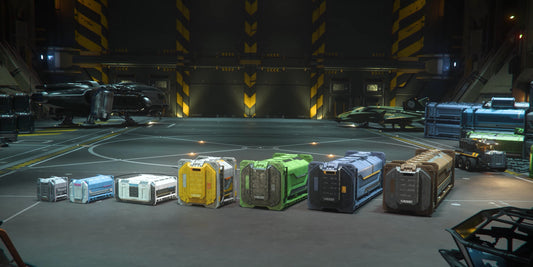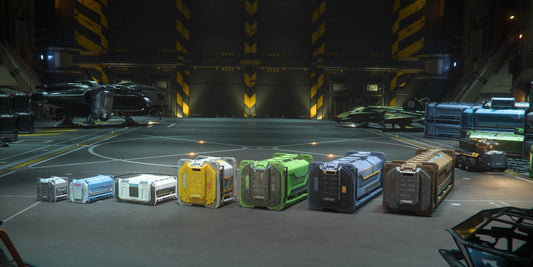Star Citizen Quantum Drive Guide: Types, Manufacturers, Performance & Best Setups
1 Quantum Drive Working Principle
1.1 Spatial Bubble Principle & Energy Management
Quantum Drive isn’t about simply accelerating a spacecraft—instead, it generates a quantum bubble around the ship. This bubble compresses space in front of the vessel and expands it behind, allowing the ship to remain locally stationary while effectively being propelled across vast distances through rapid spatial distortion. This setup is closely analogous to the Alcubierre Drive concept from theoretical physics.
To sustain this bubble, the drive must convert “quantum fuel” into a negative energy field. In reality, negative energy appears only in extremely limited phenomena like the Casimir effect. In the game, however, this is reimagined as a controlled energy conversion process. That process generates intense heat and demands robust power generation and cooling systems. Larger ships—equipped with more powerful reactors and high-capacity cooling systems—can maintain quantum flight much longer, while tiny ships like the Merlin lack the necessary power and cooling volume and therefore cannot install a quantum drive.
1.2 Launch Mechanism: Calibration, Spooling, and Jump Phases
Quantum Drive operations in Star Citizen involve several distinct phases—not simply a single jump button. Mastering these steps is crucial for smooth interstellar travel.
Phase 1: Mode Switch & System Transition
- Ships begin in SCM (Space Combat Maneuvering) mode, where standard flight systems and weapons are enabled, but quantum travel is unavailable.
- Activating NAV (Navigation) mode triggers several changes: weapons deactivate, shields collapse into a buffer, and the quantum drive automatically begins spooling—the initial energy buildup process.
Phase 2: Calibration
- Once in NAV, your ship must align precisely with the waypoint or target.
- Calibration computes the necessary parameters for the jump—direction, distance, and resource requirements. Misalignment increases calibration time, as players have noted that simply having enough power isn’t enough if the ship is not pointing correctly.
Phase 3: Spooling
- After calibration, the drive continues to accumulate energy. This is indicated via HUD progress bars and happens automatically upon entering NAV mode.
- The spooling time varies by drive model—some drives like the “Quest” calibrate in around 5 seconds due to rapid power draw, while others take longer. This variation means choosing the right drive impacts performance, especially in repeated short jumps.
Phase 4: Jump Initiation
- When calibration and spooling hit 100%, and no interference (e.g., QED suppression) is detected, the pilot can press and hold the jump key (default B) to enter quantum travel.
- At this moment, the ship is enveloped in the quantum bubble, initiating a high-speed transition toward the next waypoint.
Phase 5: Quantum Travel & Stabilization
- Once in quantum mode, you enter Quantum Cruise at high speed (~1 km/s).
- A quantum boost (QB) mode exists for shorter jumps, activated instantly and requiring no calibration—though it uses more fuel.
- For proper Quantum Travel (QT), early stages may require maintaining stabilization manually, effectively a mini-game; once stabilized, your ship can continue jump automatically.
Phase 6: Cooldown & Readiness
- Upon arrival, the drive enters a cooldown phase. While you can begin calibration for the next jump during cooldown, you must wait for the cooldown to complete before re-engaging the jump.
- If the drive fails to spool—due to damage, absence of drive, or interference—you’ll stay in SCM with limited speed and no quantum ability, often prompting players to revert to SCM to regain shields and weapons.
1.3 Limitations & Interference (Expanded)
Quantum travel offers remarkable speed and maneuverability, but it comes with several tactical and mechanical constraints—along with dedicated tools designed to disrupt or prevent quantum jumps. Here’s a deeper dive into the key systems:
EMP Interference
An Electromagnetic Pulse (EMP) can interrupt the quantum drive during its spooling (pre-activation) phase by cutting power, causing the jump to fail. This makes EMPs valuable defensive tools: for example, bounty hunters or pirates can prevent a fleeing ship from escaping via quantum travel.
Quantum Enforcement Devices (QED)
Quantum Enforcement Devices (QEDs) combine two functionalities:
- Quantum Snare: forcibly extracts ships from active quantum travel or blocks their entry.
- Quantum Dampener: prevents nearby ships from initiating or continuing quantum jumps.
Quantum Dampeners
Quantum Dampener (QDMP) is distinct—limited to only dampening quantum travel, without the “snare” capability.
These tools are pivotal in setups such as ambushes or bounty-hunting missions. The Mantis ship, for instance, is equipped with a QED capable of both disrupting and intercepting quantum jumps.
Cooling & Overload Mechanics
Quantum drives generate intense heat during extended use. Without proper cooling—or if power is diverted to weapons or other systems—ships may drop out of quantum travel due to overheating. Larger vessels with robust power generation and cooling systems, like the Idris, mitigate this risk more effectively than smaller craft.
Fleet Coordination: Quantum Linking
Quantum linking enables multi-ship coordination: one vessel acts as the Jump Leader, sets the target, and once all ships complete calibration, the entire group executes the quantum jump simultaneously. This functionality streamlines fleet maneuvers and enables tactical alignment across multiple ships.
1.4 Star Citizen Quantum Travel Configuration Guide
Quantum Drive Types & Manufacturers
Five Quantum Drive Role
In Star Citizen, quantum drives are categorized into five main roles, each designed with different priorities and tactical applications:
- Military: Short spool-up, fast cooldown. Ideal for combat, pursuit, and quick retreats, but less fuel-efficient.
- Civilian: Balanced and reliable. Commonly used for everyday transport and general-purpose missions.
- Industrial: Optimized for long-range and low fuel consumption. Great for bulk hauling, though slower to start and accelerate.
- Competition (Racing): Focused on extreme speed. Perfect for racing or short high-mobility runs, but extremely fuel-hungry.
- Stealth: Reduces signature during quantum travel. Suited for smuggling or infiltration, but overall speed and efficiency are lower.
Common manufacturers include:
- RSI (Roberts Space Industries): Atlas, Hemera → Balanced and reliable.
- Wei-Tek: VK-00, TS-2, XL-1 → High-speed, military-grade performance.
- ArcCorp: Echo, Allegro, Flash → Economy and balanced types.
- Juno Starwerk: Vulcan, Balandin → Industrial and long-range focus.
- Ace Astrogation: FoxFire, LightFire → Civilian basics and light craft.
The drive’s role type and manufacturer determine its core attributes, including maximum quantum speed, fuel efficiency, spool-up time, and cooldown performance. Players should choose the most suitable combination based on their ship type and mission (combat, cargo hauling, stealth, racing, etc.).
Quantum Drive Role × Example Models × Performance Data
Quantum Drive Role Comparison Table (1–10 Scale)
Read Guide:
- Speed = Top velocity in quantum travel (higher = faster).
- Fuel Efficiency = How far you can go per unit of quantum fuel (higher = more efficient).
- Spool-up = Time needed to start a jump (higher = faster response).
- Stealth Signature = Detectability during quantum (higher = harder to detect).
How to Choose a Quantum Drive? (Player Role Guide)
- New Players / General Transport: Recommended Type : Civilian. Balanced performance, good fuel efficiency, and reliable operation with minimal overheating risk; perfect for daily missions and general travel. Example Models: RSI Atlas (S1), ArcCorp Allegro (S2).
- Traders / Long-Haul Cargo: Recommended Type : Industrial. Exceptional fuel efficiency and long range, ideal for bulk hauling and interstellar routes, though slower in speed and spool-up. Example Models: Juno Balandin (S2), ArcCorp Agni (S3).
- Bounty Hunters / Combat Pilots: Recommended Type : Military. Fast spool-up and cooldown make it excellent for pursuits and combat retreats, but high fuel consumption requires frequent refueling. Example Models: Wei-Tek TS-2 (S3), RSI Hemera (S2).
- Racers / High-Mobility Runs: Recommended Type : Competition. Extreme top speed and rapid response, perfect for racing or fast deliveries, though fuel usage is very poor. Example Models: Wei-Tek XL-1 (S2), RSI FoxFire (S1).
- Smugglers / Infiltration Players: Recommended Type : Stealth. Low signature quantum travel for covert ops and smuggling, trading off speed and efficiency for stealth advantage. Example Models: ArcCorp Echo (S3), Ace LightFire (S1).
Supporting and Auxiliary Components
- Coolers: Used to dissipate the high heat generated by the quantum drive and prevent long cooldown delays after overheating. Standard stock coolers are often insufficient for sustained long-distance travel; upgrading to more efficient models (such as the Ardent or Array series) is recommended. Advanced coolers can significantly shorten post-jump cooldowns or nearly eliminate them, greatly improving back-to-back jump capability.
- Power Plants & Batteries: The power plant is the ship’s energy source, with output varying by size and model. A powerful plant ensures the quantum drive can operate at full capacity. Ships equipped with batteries can maintain drive power even if the main plant goes offline—batteries function like “supercapacitors,” providing a temporary burst of energy. This helps stabilize power supply during flight and may reduce spool-up time. Power distribution systems (the power triangle) allow pilots to dynamically allocate power to engines, weapons, or shields, which indirectly affects the drive’s responsiveness, though not its maximum cruise speed.
- Fuel Tanks: Quantum fuel tank capacity determines available fuel and directly affects maximum range. Larger-class tanks (e.g., S2 or S3) can store more fuel, enabling longer uninterrupted travel. For extended journeys, carrying a high-capacity quantum fuel tank is essential.
- Other Auxiliary Modules: Currently, the game does not provide specialized “power distributors” or “quantum capacitors” dedicated to quantum travel. However, using efficient power plants and batteries, along with proper flight management (such as shutting down nonessential systems during jumps), can optimize performance. In combat zones, emergency quantum refueling/recharging stations (QBase) can also replenish fuel or provide an instant energy boost, though these are space facilities rather than onboard components.
Performance Metrics and Component Impact
- Maximum Quantum Cruise Speed: Primarily determined by the drive’s own specifications. Competition and military drives are typically the fastest—for example, the Wei-Tek XL-1 (S2) can reach about 324,000 km/s (~1.08c), while the Wei-Tek TS-2 (S3) reaches up to 395,000 km/s (~1.316c). In general, Size 1 drives fall in the 0.5c–0.9c range, Size 2 drives approach 1.0c, and Size 3 drives can exceed 1.3c. Economy drives are slower but consume less fuel. A sufficiently powerful ship power system ensures the drive can achieve its rated maximum speed, but never beyond its design limits.
- Fuel Efficiency (Range per Unit Fuel): Measured in liters consumed per million kilometers (L/Mkm). The lower the value, the more efficient the drive. Economy drives consume extremely little fuel—for example, the ArcCorp LightFire (S1) uses only about 4.9 L/Mkm. In contrast, high-speed military drives burn enormous amounts, with the TS-2 consuming about 141.7 L/Mkm. Component impact: larger fuel tanks don’t reduce fuel consumption per distance, but they increase total range. Power plants and coolers don’t directly affect efficiency either, though overheating or insufficient power can force the drive to throttle down, reducing practical efficiency. Ultimately, players must balance speed vs. fuel cost depending on their mission needs.
- Acceleration and Time-to-Speed: Once a quantum jump is initiated, the ship almost immediately reaches full cruise velocity. The acceleration phase essentially completes once spooling is done. In practice, this means acceleration during flight is negligible—the main time cost comes from spooling and stabilization, not from ramping up to speed. In effect, reaching top speed is nearly instantaneous after the jump begins.
- Spool-up and Calibration Time: Spool-up is the period required to prepare the drive for a jump. Size 1 drives typically take around 4 seconds (e.g., RSI Atlas at 4s), Size 2 around 6 seconds (e.g., RSI Hemera at 6s, ArcCorp Flash at 6s), and Size 3 up to 7 seconds or more (e.g., Wei-Tek TS-2 at 7s). Spool time is tied to drive size and design—the larger and more powerful the drive, the slower the startup. Calibration refers to locking onto a target destination, usually only a few seconds, and is not strongly tied to drive model (more a matter of player aiming at the target marker). Advanced coolers and strong power plants can help stabilize the drive during spooling, but spool duration is largely an inherent property of the drive itself.
Insights:
- Speed increases with drive size, but so does spool-up time and fuel demand.
- Economy drives (like LightFire, Agni) offer very low consumption but lower speeds.
- High-performance drives (like XL-1, TS-2) are extremely fast, but at the cost of efficiency.
- Power plants & coolers mainly affect stability (avoiding heat/power throttling), not baseline stats.
Recommended Configurations (by Drive Size and Ship Type)
- Small Fighters (commonly S1 drives): Choose high-speed military or racing drives, such as RSI Atlas (S1, ~0.77c, excellent all-round performance) or Wei-Tek VK-00 (S1, ~0.89c), which balance speed and durability. Since S1 drives consume fuel moderately, a medium-sized fuel tank is sufficient for short-range combat needs. Upgrading to advanced coolers is essential to prevent overheating and delays in chaining jumps, and the power plant should be properly matched to ensure stable output during spool-up.
- Multipurpose / Cargo Ships (commonly S2 drives): For efficiency and endurance, opt for RSI Hemera (S2, ~0.94c, ~8.39 L/Mkm fuel consumption) or ArcCorp Flash (S2, ~0.67c, ~12.64 L/Mkm). These drives provide moderate speed but excellent reliability, and when paired with large fuel tanks, are ideal for long-haul transport. If higher speed is required, consider Wei-Tek XL-1 (S2, ~1.08c) or Yeager (S2, ~0.83c, civilian), with a high-capacity fuel tank. Note that high-speed drives generate more heat and require more power, so it is advisable to install powerful coolers and a stronger power plant. Carrying an auxiliary battery can also provide extra energy when needed.
- Large Transport Ships / Capital Vessels (commonly S3 drives): Depending on the mission, choose between economy and performance drives. For long-distance trade, use the ArcCorp Agni (S3, ~0.21c, very low fuel burn, excellent for long-range travel) with oversized fuel tanks. For assault or rapid-response missions, use Wei-Tek TS-2 (S3, ~1.316c, very fuel-hungry) or Pontes (S3, civilian, balanced mid-high speed with lower consumption). Large ships usually have sufficient space and capacity for multiple high-power coolers and large fuel tanks, reducing cooldown intervals and extending range.
- Auxiliary Component Setup: Regardless of configuration, always prioritize advanced coolers to maximize sustained quantum travel capability. Power plants should provide ample output (upgrade if necessary), and auxiliary batteries are recommended for emergency stability. Fuel tanks should be scaled according to mission requirements. For power distribution, allocate more resources to engines and drives to reduce spool-up limitations. Common “community-recommended” setups include: S1 fighters using Atlas + advanced cooler + matching power plant, S2 multipurpose ships using Hemera or Flash + large fuel tank, and S3 large ships using TS-2 or Pontes + oversized fuel tanks + efficient coolers. These are among the most popular optimal builds in Alpha 3.x and later versions.
2 The History of the Quantum Drive in Science Fiction
2.1 Timeline Overview
- 1940s–1950s: Foundations of FTL terminology (pre-“quantum”): Post–WWII, the idea of faster-than-light engines emerged in science fiction, with “warp drive” becoming the most recognized thanks to Star Trek. The phrase “warp drive” appeared in the 1940s, and John W. Campbell’s 1957 novel Islands of Space helped systematize the concept. This set the linguistic groundwork for later “quantum” propulsion naming.
- 1986: Arthur C. Clarke’s The Songs of Distant Earth: Secondary sources note that Clarke tied the Quantum Drive to zero-point energy (ZPE) in this novel, embedding it within a framework of large-scale interstellar travel. This is one of the earliest textual uses of “Quantum Drive” as propulsion.
- 1994 (Real-world theory): Alcubierre Warp Drive: Miguel Alcubierre proposed his famous “warp bubble” solution in general relativity, compressing space ahead and expanding space behind a ship. This “curvature bubble” heavily influenced later depictions of “quantum drives” as spacetime or vacuum-energy manipulators.
- 1998: Star Trek: Voyager introduces the “Quantum Slipstream Drive”: In episode S4E26 Hope and Fear (1998-05-20), the Quantum Slipstream Drive (QSD) first appeared. It became a staple in Voyager extended lore, merging “quantum” branding with established FTL tropes.
- 2017: The Orville: This series explicitly named its standard FTL engine the Quantum Drive. It works much like a warp analogue but is presented with a modernized vocabulary that emphasizes quantum spacetime manipulation.
- 2019–present: Star Citizen: The game systematized Quantum Drive / Quantum Travel as both lore and gameplay. It introduced mechanics such as spooling, calibration, fuel, overheating, and interdiction (Quantum Enforcement Device), embedding the concept into an interactive engineering system.
2.2 Thematic Development
- “Quantum” as a semantic upgrade:The term quantum was often attached to propulsion to lend scientific authority or mystique. Dictionaries of science fiction terminology note how “quantum” became a buzzword after the mid-20th century.
- Theoretical influences:Alcubierre’s 1994 warp drive proposal gave a hard-science framework—compressing/expanding spacetime—that later fiction tied to “quantum fields,” “negative energy,” and “vacuum manipulation.”
- Quantum Slipstream as Trek’s innovation:Voyager’s QSD combined quantum branding with engineering risks (benamite crystals, phase stability), moving beyond mere naming into pseudo-engineering details.
- Game mechanics:Star Citizen integrated Quantum Drive as a playable system—spool-up, calibration, interdiction, overheat—effectively gamifying FTL balance.
2.3 Representative Works
- Literature :The Songs of Distant Earth (Arthur C. Clarke, 1986): ties “Quantum Drive” to zero-point energy.
- Television / Film: Star Trek: Voyager (1998): Quantum Slipstream Drive introduced in Hope and Fear. The Orville(2017): Quantum Drive as standard FTL across the Union fleet.
- Games Star Citizen (2010s–present): Quantum Travel implemented as a complete mechanic, including fuel, interdiction, spooling, and overheating.
Other FTL terms (warp, hyperdrive, jump, slipstream, wormholes) created the ecosystem into which “quantum drive” naturally fit.
2.4 Distinguishing from Real “Quantum Engines”
Media reports sometimes mention “quantum engines” in reference to quantum heat engines or micro-scale devices that use entanglement or coherence for efficiency. These are real quantum thermodynamics experiments—not FTL drives.
2.5 Conclusion
- Origins: The phrase “quantum drive” entered SF discourse with Clarke (1986) and gained mainstream visibility via Voyager (1998).
- Science link: Alcubierre’s 1994 warp bubble theory gave narrative writers a pseudo-scientific framework.
- Media evolution: TV shows emphasized engineering risks, games emphasized mechanics and balance.
- Real-world distinction: Actual “quantum engines” studied in physics today are about energy conversion at quantum scales, not FTL.
3 Quantum Drive History in the Star Citizen Universe
- 2075 – The Genesis of Quantum Travel: On May 3, 2075, Dr. Scott Childress and his team at Roberts Space Industries (RSI) successfully completed the first self-sustaining Quantum Core Engine—a pioneering advancement in space propulsion that enabled travel at 1% of the speed of light. This innovation marked the beginning of humanity’s expansion beyond the solar system.
- 2214 – A Major Leap Forward: In 2214, RSI unveiled a refined version of the Quantum Drive—the Poseidon fusion engine—which elevated achievable travel speeds to 10% of the speed of light, dramatically enhancing humanity’s interstellar reach.
- Current Era – Reaching 20% Light Speed: In the modern setting of Star Citizen, Quantum Drive technology has advanced even further, with typical engines now capable of reaching 20% of the speed of light (0.2c), providing efficient and practical interstellar mobility.

